Creating the right ecommerce shipping strategy for your online store is essential to winning loyal customers, boosting profitability, and ensuring your overall success. It’s no less important than selling high-quality products or understanding the basics of ecommerce accounting.
With most online shoppers expecting short delivery times and free shipping, it makes sense for many online stores to focus on speed and price — and those things are integral to a good fulfillment strategy. But shipping ecommerce orders is really about so much more than that. A well-designed shipping process also helps minimize mistakes, reduce returns, lower operating costs, foster positive customer relationships, and reinforce your brand identity.
Are you ready to optimize your approach to ecommerce shipments? Use this guide to develop a shipping approach that streamlines your operations and delights shoppers.
Ecommerce shipping solutions for your store
↑ Back to topFrom packing up an order to delivery confirmation, many steps are involved in the fulfillment process. It starts with choosing packaging, determining the best shipping services and methods, and calculating shipping costs. Next, you need to print labels, get the packages to the carrier (or schedule pickups), keep customers informed with tracking and status updates, complete delivery, and manage customer service.
The entire process can get quite complex, so the first thing you’ll want to determine when developing your ecommerce shipping strategy is who will be responsible for fulfilling your orders. Will you pack and ship them yourself? Will they ship direct from the fulfillment center, manufacturer, or wholesaler? Or will you contract with a third-party logistics provider (3PL) to handle all your order fulfillment?
Let’s take a look at some ecommerce shipping solutions and walk through the ideal use cases for each as well as their pros and cons.
1. Fulfill in house
Shipping from your own fulfillment warehouse, production facility, or retail location can be a cost-effective solution that provides maximum quality control, but it does require more work. The right inventory management systems, however, can help a lot — and those efforts can pay off in a big way, like they did for Boost Oxygen.
Ideal use cases for managing your own end-to-end fulfillment:
- You have one or more staffed warehouses already.
- You manufacture your own products.
- Your products are for local delivery or are time-sensitive (e.g. restaurants, floral shops, bakeries, laundry services, etc).
Pros of shipping orders yourself:
- You have complete control over the ecommerce shipping process and can customize it to your needs. Whether it’s ensuring certain types of orders are packed a particular way, guaranteeing orders are shipped out next-day, creating branded packaging, or using eco-friendly materials — you control it all.
- You can save money on third-party warehousing fees and ensure the best shipping rates by shopping around or using a service like WooCommerce Shipping that takes care of it for you.
- You can build relationships with customers by hand-writing thank you notes or including small gifts in their orders.
Cons of shipping orders yourself:
- Shipping can be time-consuming, particularly if you have a high volume of orders. You’ll need to have staff available who can pack orders, print labels, and arrange carrier pickup or drop-off.
- You must purchase your own shipping supplies and equipment.
- If you’re delivering locally, you might need to purchase and maintain one or more delivery vehicles.
- You might need to hire additional staff to manage inventory and shipping as your store grows or when you experience a spike in orders, like during the holiday shopping season.
2. Ship direct from manufacturers
Instead of ordering goods wholesale and storing them in your own warehouse while you wait for orders to come in, you could have your suppliers dropship them directly to the customer.
Dropshipping is often associated with smaller online businesses, but it can be a great option for big ecommerce businesses, too. In fact, Wayfair got its start as a dropshipping-only business. They eventually expanded to using their own warehouses, but they still use the dropshipping model for a lot of their products.
Houzz, a competitor of Wayfair, still uses the dropshipping model exclusively. In 2024, Houzz was valued at $1.83 billion. Not too shabby for a company that doesn’t design, manufacture, or ship the products it sells.
Ideal use cases for dropshipping:
- Your business sells items from a single manufacturing facility that has the capability to ship directly to your customers.
- Your online store is a marketplace style business like Etsy, eBay, Houzz, or Wayfair where items are listed by many different individual sellers.
- You have no brick and mortar retail locations and sell large items, like furniture, from a variety of manufacturers that might be complex and expensive to import and store.
Using a dropshipping service has its benefits, but it also has some downsides. We’ll go over the pros and cons of dropshipping so you can make the best decision for your ecommerce business.
Pros of dropshipping:
- It’s low-cost. You don’t need to invest in inventory up front, and you don’t need to staff your own shipping operation.
- You can be more flexible with the products you sell. You can easily adjust your product offering as needed, and you’re not tied to a specific inventory. This gives you the ability to quickly respond to changes in demand.
Cons of dropshipping:
- You have less control over the types of products you offer. If you want customized products, you’ll probably need to consider print on demand or place wholesale orders with manufacturers.
- You have less control over the quality of your products. You might be able to quality-check initial samples, but you won’t be able to examine every item that goes out with every order. If the products don’t meet your standards or customer expectations, it can reflect poorly on your business.
- Longer and less reliable shipping times might be frustrating for customers and lead to lost sales. Because you’re relying on a third party to fulfill orders, there’s always the potential for delays — especially if the products are coming from overseas. If you’re using multiple dropshipping companies, products in an order may arrive in different packages on different days, leading to customer confusion and increased support tickets.
- Shipping issues can take longer to resolve. When you ship products yourself or use one 3PL company, you can respond to customer service issues more quickly. If you’re working with several dropshipping companies, you might have delays in communication that extend the amount of time it takes to resolve a customer complaint.
3. Use a third-party logistics (3PL) service
If you’re a growing company with a high order volume, you might benefit from using more distributed warehousing and shipping solutions. But there can be a lot of expense involved in renting or purchasing warehouse facilities, staffing them, and managing their logistics. Fortunately, there are a number of third-party logistics providers that can handle your ecommerce shipping for you while keeping your costs affordable and predictable.
Ideal use cases for 3PLs:
- You want to reduce shipping time for your products by distributing inventory across multiple fulfillment warehouses, either regionally, nationally, or internationally.
- You want your products to ship from the same locations (rather than dropshipping from multiple suppliers) and aren’t currently able to, or interested in, investing in your own warehouse operations.
Pros of using a 3PL fulfillment service:
- A fulfillment service can handle the entire shipping process for you, including packing, tracking, and delivery.
- They often have relationships with major carriers, which can save you money on shipping costs.
- They can scale up quickly to meet spikes in demand.
- You don’t have to hire your own staff to manage shipping and fulfillment, which reduces your time spent on management duties.
- You don’t have to keep your inventory in your own facilities, which can reduce overhead costs and keep your offices or retail spaces less cluttered.
Cons of using a 3PL fulfillment service:
- You will have less control over the shipping process and may not be able to customize it to your needs.
- You may need to pay monthly fees to the fulfillment center for storage and per-order packing and handling fees in addition to shipping costs.
- At least some aspects of your customer service would be handled by the 3PLs. Some businesses may see this as a cost savings (and therefore a pro, not a con), but some customers may prefer to deal directly with the store rather than a third party. Plus, when you have to spend time communicating with your 3PL to resolve a delivery issue, rather than directly with the carrier, ticket resolution times may grow longer and it might be more difficult to meet customer expectations.
So, what’s the best shipping solution for your business? Ultimately, the option that’s right for you will depend on a number of factors beyond what we’ve listed above. You’ll need to consider what your business’ goals and limitations are and weigh the pros and cons of each option. In the end, you may even decide on a mix of fulfillment solutions. You don’t have to pick just one!
Shipping carriers and methods
↑ Back to topNo matter what fulfillment option you choose, you’ll still need to familiarize yourself with the various shipping methods and carriers as that information needs to be accurately entered into your ecommerce platform’s shipping settings. You’ll also need to ensure that your carriers and shipping methods are up-to-date on the frontend for your customers — especially if you’re giving them multiple options during checkout.
Make sure that you choose the right options for any shipments coming from your manufacturing facilities to your warehouses or wholesalers. For instance, air freight may be faster, but if you’re shipping large volumes, you’ll get a better price by transporting your products on an ocean freight container.
Factor in shipping zones and delivery time
Before you choose your shipping carriers and methods for your online business, think through a few key variables:
Shipping zones: Where in the world are you shipping?
Are you currently only shipping domestically? Are you considering expanding into international shipping with a few other countries? Are you shipping worldwide and reexamining that strategy?
Whether you’re looking to expand your market or scale back to focus on the ones that are most profitable, there are a few things to consider when deciding which countries your ecommerce store should serve.
- Where are your products, or products like yours, most popular?
- Where can your products legally be shipped?
- What kinds of registration and paperwork must be completed so that your company can make sales and ship to customers in a given country?
- How expensive is it to ship to a specific country? Besides fees from international shipping services, what are the taxes, customs, or tariffs you need to be aware of? International shipping can be expensive — especially next-day shipping services like DHL Express or FedEx® International Next Flight — so you’ll need to factor that into your decision.
- What are international relations like between your country and the countries you’re considering?
- How reliable is delivery service in a particular country?
Processing returns through international services and handling customer support for overseas shipments can also be challenging and time consuming. There may be language and cultural barriers that affect the quality of customer service you can provide and servicing returns, repairs, or replacements on internationally-shipped products may take much longer than for domestic orders.
If you take all of these factors into account, you should be able to narrow down your list of potential countries to ship to. From there, start researching the specific rules and regulations for each country to make sure your ecommerce store is prepared to ship successfully.
Pro tip: Legal and customs requirements can vary dramatically by country and region. Make sure that you partner with an international shipping company that can automate as much of the delivery process as possible.
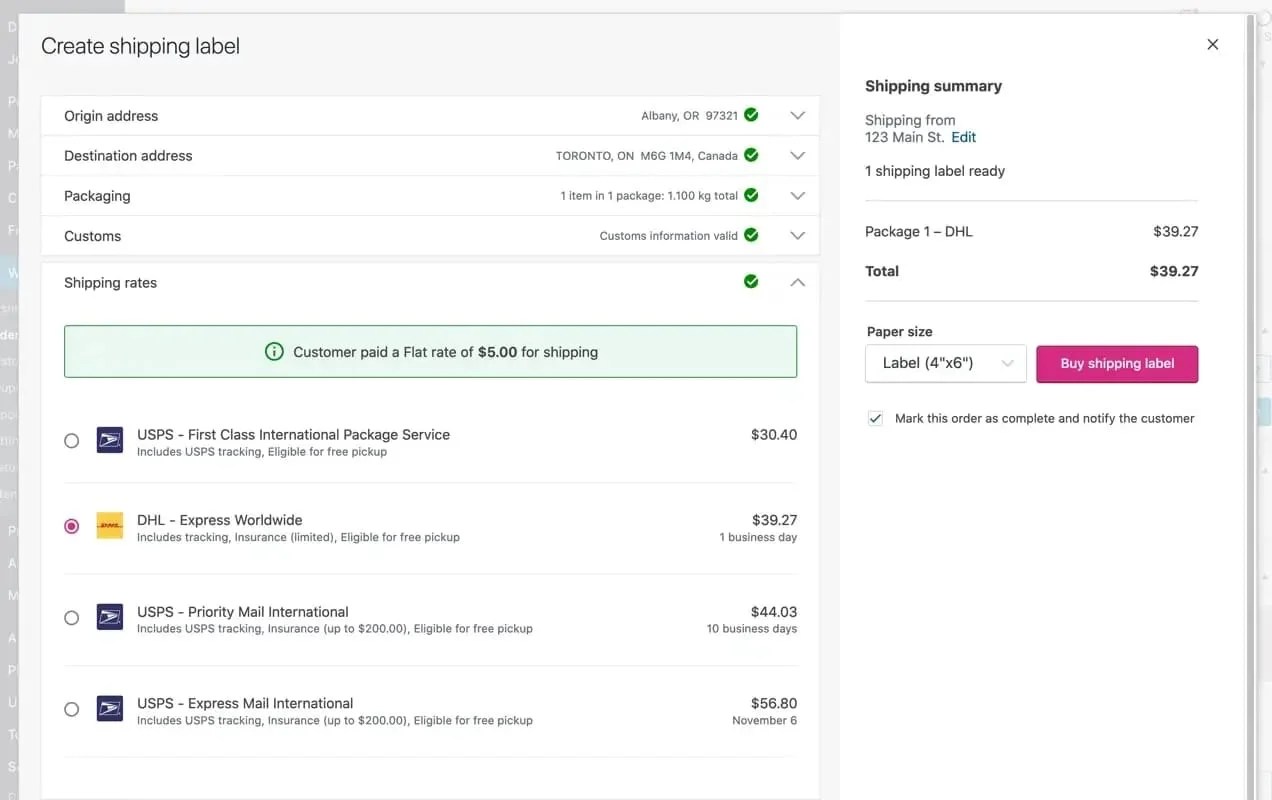
WooCommerce Shipping has partnered with DHL — so now you can manage international orders from directly within your dashboard. You’ll also save up to 67% on shipping labels, receive free pickups, be able to provide customers with end-to-end tracking, and enjoy automated customs forms creation.
Delivery times: How fast do your packages need to get to their destination?
Decide on delivery times and shipping methods for your ecommerce store that best suit your business. You’ll need to choose shipping options that can get your products where they need to go in a timely manner. If you’re selling items that are time-sensitive, such as food or cosmetics, this is even more important.
Evaluate shipping times from the beginning of the supply chain to delivery at the customer’s doorstep. If you can adjust your order cycle to allow for longer lead times, you can choose a slower delivery speed on goods from their origin to your warehouse without impacting the delivery time of customer orders.
If you’re currently shipping to local or regional warehouses and then dividing shipments between direct sales customers and your retail locations, you may be able to save shipping costs by splitting the shipments at the manufacturer and shipping products for online orders to your warehouses or 3PLs and products for your brick-and-mortar stores directly to your retail locations.
Depending on where you’re shipping to and how quickly your products need to get there, you might use multiple shipping services and methods like:
- Standard Shipping: UPS Ground, 1-5 business days
- Expedited Shipping: USPS Priority Mail, 1-3 business days
- Overnight Shipping: FedEx Priority Overnight, 1 business day
- Express International Shipping: DHL Express Worldwide, next possible business day
You can look at each shipping service’s website and review shipping methods and rates to determine which may be the most affordable options for your business that also provide the quickest delivery times. If you’re using a multi-carrier shipping software on your store, you can review rates from several carriers at once to quickly determine which will be the best fit.
By offering fast and reliable shipping, no matter where you ship to, you can ensure that your fulfillment process runs smoothly and customer satisfaction will be high.
Pro tip: If you’re using a 3PL service, they will default to whatever method is cheapest for them and for your business. If you need items to arrive in the same package, even if it’s more expensive, or split things up over multiple packages for some reason when it would be cheaper to put them in one larger box, you’ll need to inform your 3PL so they can follow your procedures. If you’re packing and shipping things yourself, you have more complete and granular control over this process.
How to package orders for shipment
↑ Back to topWhether you are shipping products yourself, using a 3PL service, or dropshipping direct from your supplier, ensure that all your items are packaged safely, securely, and cost-effectively.
Destination, carrier, and shipping methods all influence your shipping costs and practices. But equally important is considering how your orders are packaged.
Before you start shipping, consider how many of each item can fit into a single package, whether some products should be shipped separately, and how you will protect them from damage due to exposure to the elements, dropping, stacking, and agitation during transport.
Don’t forget that packaging is also an excellent opportunity for online sellers to communicate their brand, enhance customer satisfaction, and differentiate themselves from competitors.
Of course, you don’t want to end up losing money when you mail products by using excessive, needlessly-expensive packaging, so it’s important to carefully balance your approach. Let’s take a look at some best practices in packaging products and orders for shipment.
1. Keep packages small and light
The larger and heavier a package is, the more expensive it will be to ship. Also, larger and more unwieldy packages may be more likely to get dropped. A parcel of notable size may also attract the attention of package thieves. Smaller packages will save money while being easier to handle safely and deliver discreetly.
There are typically three levels of packaging — primary, secondary, and tertiary. The primary level of packaging is the layer that customers directly interact with. It could be something like shrink wrap, molded plastic, a jewelry box, or the tube your toothpaste comes in.
The secondary layer of packaging includes materials for multi-packs, retail display packaging, or adding layers of packaging for security or retailer requirements (for instance, Costco’s packaging requirements are quite rigorous and specific). Tertiary packaging is for transit to your warehouse or customer.
To conserve space and reduce tertiary package weight, make the primary and secondary packaging as space efficient as possible. Use thinner materials like paperboard and shrink wrap for secondary packaging (or eliminate secondary packaging altogether) and use packaging shapes that are optimized for space conservation.
If products can be assembled by the customer, instead of arriving fully-assembled, you can save money by providing assembly instructions along with component parts. Major brands like IKEA have made customer product assembly a foundational part of their brand personality, proving that value-seeking shoppers will not find the extra work off-putting and will appreciate the cost savings. However, this is certainly not the case for every brand and target customer, so this consideration must factor into packaging decisions.
2. Combine order items into a single package when it makes sense
If there’s a mix of products in an order, you might ship them together if the small items can actually function as padding, are lightweight, or fairly damage-resistant. For instance, let’s say your business sells baby toys and accessories. A set of wooden alphabet blocks, baby blankets, and teething toys could be safely packed in a single box with little risk of damage.
3. Ship items separately when safety and practicality are a concern
If a customer orders two very different products — like a pair of crystal champagne flutes and a set of free weights — you probably don’t want to ship those in the same box. You may also want to break the order up over several packages to prevent damage if the items are fragile or prone to warping or compression under pressure.
For instance, if you’re mailing 20 18” x 24” canvas prints, it wouldn’t be a good idea to ship them all in the same box. The compounded weight of each item could cause damage to the canvas below it. Plus, there may be much higher shipping costs for using an oversized box.
If items ship from separate locations, you would, by default, need to ship packages separately. While shipping things separately can cause confusion for customers, sometimes it is a better option to ensure a package is shipped at the best price and arrives in a timely manner, undamaged.
4. Choose the right packaging materials
Your choice of packaging materials is key to ensuring safety and minimizing expense. When choosing packing materials for ecommerce orders, consider the following:
- Item fragility
- Customer accessibility
- Eco-friendly materials
- Packaging cost vs quality
Fragile merchandise
If you’re shipping fragile items, use different packing materials than if you’re shipping non-fragile items. You may need extra bubble wrap, foam, or air cushions to ensure items arrive safely. Additional packing materials may increase your overall package size, but making sure products arrive safely will save money on returns in the long run.
Take into account whether or not items will be damaged by water or other elements during shipping. Consider wrapping products that could be damaged by water in shrinkwrap, a plastic overbag, or other waterproof packaging. If using a bubble mailer, choose a plastic one instead of a paper one.
Accessible packaging
If your products are intended for people with certain disabilities, consider packaging design that is easier for them to read and open. Using high color contrast and tactile elements like braille, perforations, and tabs can help make packaging easier to understand and open for those with visual impairments.
For those with mobility issues, packages with easy-open tear strips, light tape usage, and no glues provide a better overall experience.
Eco-friendly materials
If you want your business to use environmentally-sustainable packaging materials, there are definitely options out there. You may even use eco-friendly packing materials as part of your marketing strategy. If you’re selling products that are nature-related, organic, or simply value sustainable manufacturing practices, it might make sense to invest in eco-friendly packaging.
Companies like Hero Packaging, Mushroom Packaging, and Noissue offer sustainable packaging options. Noissue even offers customized branding on packing materials. Environmentally-friendly packaging is sometimes more expensive than other materials, so keep that in mind if you’re trying to stay within a specific budget.
Packaging cost vs quality
Some packing materials are more cost-effective than others, but don’t choose based on price alone. The same kraft mailer from Company A at $50 per case may not be as good of quality as the ones from Company B for $75 a case. Do they both do the job? Maybe. It’s possible the self-seal on the cheaper mailers doesn’t perform as well as the more expensive ones. If your seal fails and products get lost, did you really save any money?
There are many different packing materials available, so it’s important to choose the right option for your business. Consider products, shipping needs, budget constraints, and the impression you want to make on customers when choosing packaging materials. With the right materials, you can ensure that products arrive safely at their destination, minimize environmental impact, and maximize positive customer experience.
5. Use highly-visible product and package labeling
Whether packaging products at the factory for shipment to warehouses or 3PLs, or putting together orders for customers, clear package labeling that’s large enough to easily read or scan with a bar code reader will ensure products are picked and packed correctly and minimize the risk of products getting lost at any given facility or during transit.
While it’s helpful to have the product name and branding on the package, use a unique sku for each product and an associated barcode.
Manufacturers will typically provide guidance on the right size of box and number of items to maximize how many boxes can fit on a container and minimize shipping expense. So, if you’re shipping from a manufacturer to warehouses, 3PLs, or to wholesale buyers, work with them to design custom-printed shipping boxes of the correct size that include the SKU, barcode, product name, brand name, and customer service contact information.
If products are fragile or temperature sensitive, include information to that effect in large, bold print on the shipping boxes.
For orders shipping to end customers, the package should — at minimum — have a legible shipping label with return address. Since packages may contain a mix of products, use waterproof or water-resistant stickers (instead of direct print) on the packaging indicating any special handling.
6. Provide a branded experience
Packaging is an opportunity to make a good first impression and give customers a glimpse of your brand identity. Add your company’s logo, color scheme, and unique messaging to different packaging elements — like tissue paper, boxes, envelopes, and even packing tape — to make everything a branded customer experience.
When a box with your logo on it arrives at someone’s doorstep, they’ll know who it’s from and it can add a little more excitement to their day. Plus, seeing that your company is going the extra mile for packaging can build trust that you’re also putting just as much effort into products.

Determine shipping rates for customers
↑ Back to topNow that you know where you’re shipping, how you’re packaging, what carriers and methods you’re using, and how weight and size impact your ecommerce shipping options, it’s time to calculate two things: shipping and handling costs and the shipping rates to charge customers.
Back in the heyday of the infomercial, it was typical to see a product price listed alongside a shipping and handling fee. Customer expectations have evolved since then, with more and more demanding free shipping. Since 48% of cart abandonments are due to unexpected costs, consider wrapping shipping and handling fees into product prices or making shipping and handling charges clear and easily understandable early in the checkout process.
What are handling costs?
Handling is everything involved in packing and shipping an order except for the actual shipping fee that the carrier charges. Handling can include, but is not limited to:
- Cost of shipping supplies like boxes, padding materials, backing boards and plastic sleeves, tape, labels, and a thermal printer.
- Cost of storing inventory.
- Time spent packing orders and arranging carrier pickup.
- 3PL fees.
- Customer service regarding lost or damaged packages and communicating with customers on the status of their shipments.
A quick way to determine the average handling cost per order is to calculate what you spend per month on average on the costs listed above and then divide that by the average number of orders placed per month. Then add that handling cost to the shipping price of each order.
If you’d rather add the handling cost into product prices, you could divide your average monthly handling cost by the average number of products sold per month. If you have a mix of high-priced and low-priced products, you might want to proportionally distribute the handling costs. Cheaper products will likely have lower handling costs associated with them than more expensive products, although this isn’t always the case.
What’s the best strategy for calculating shipping rates?
Now that you have a broad understanding of shipping methods and an idea of what to charge for shipping, it’s time to think about your shipping strategy. The goal is to choose a combination of carrier, method, and pricing that meets customer needs without eating into profits. Let’s take a look at a few options:
Live rates
Live rates calculate shipping fees based on size, weight, and distance, which are synced in real time with carriers (FedEx, UPS, USPS, etc.) based on what they charge. Live rates are a popular choice because they offer a nice combination of choice and transparency. Customers can see the range of shipping options, based on speed, from least to most expensive.
Table rates
Table rates use a set of rules to calculate shipping based on factors like product prices, sizes, order totals, and destinations. This provides the highest level of customization. You might charge $5.00 for anything that weighs less than eight pounds, $10.00 for anything that weighs eight pounds or more, and offer free shipping only to the state of New York. With the WooCommerce Table Rate Shipping extension, you can create custom rules seamlessly.
Flat rates
Flat rates simplify shipping by taking the guesswork out of calculating rates. Charge the same amount regardless of the weight or size of the order. This is a great option if your inventory is consistent in size and weight, or if most customers order similar quantities. With default WooCommerce settings, you can charge a flat rate per item, a percentage-based cost, or a minimum fee.
Free shipping
Free shipping is a popular way to handle shipping. It makes customers happy and it’s simple to implement — but reduces margins. You could include the cost of shipping in the product’s price, but customers might be turned off by the higher dollar amount. Or keep pricing low and shipping free, in the hope that increased sales will make it financially worthwhile.
Combined shipping
Combined shipping options provide the best of both worlds. If a one-size-fits-all approach to shipping doesn’t align with your business needs, you can always mix and match. One approach that can benefit both your ecommerce business and shoppers is to enable free shipping for orders that meet a minimum total. Customers feel like they get instant savings when they add more products to their cart and your store increases its average order value.
Read our full guide on shipping strategies and learn how to make them work for your business.
Will you offer shipping insurance?
Some shipping methods include basic shipping insurance with a maximum value. Other methods require that you purchase insurance separately — especially in the case of high value items. Allowing the customer to purchase insurance or including basic insurance in the cost of shipping can give customers added peace of mind.
As an alternative to carrier-supplied insurance, there are third-party package protection services like Route or ReturnGO. These services charge a fee to customers at checkout and will offer broader benefits than regular package insurance, like replacing lost packages, handling returns and exchanges, and even managing customer support tickets.
Shipping strategies for ecommerce stores with multiple retail locations
↑ Back to topEcommerce stores come in all shapes and sizes. Some operate exclusively online. Others have a single office or retail location. But some of the world’s biggest online shops belong to global companies with hundreds, if not thousands, of retail locations.
Effectively coordinating inventory, logistics, and customer expectations across multiple sites can significantly influence profitability, customer satisfaction, and brand reputation. Here are some strategies that ecommerce stores with several retail locations can adopt to streamline their shipping processes:
1. Use a centralized inventory management system
A centralized inventory management system provides real-time visibility of stock across all retail locations. This allows businesses to quickly determine the best location from which to fulfill each order, maintain accurate and synchronized stock levels, and minimize stockouts and overstocks.
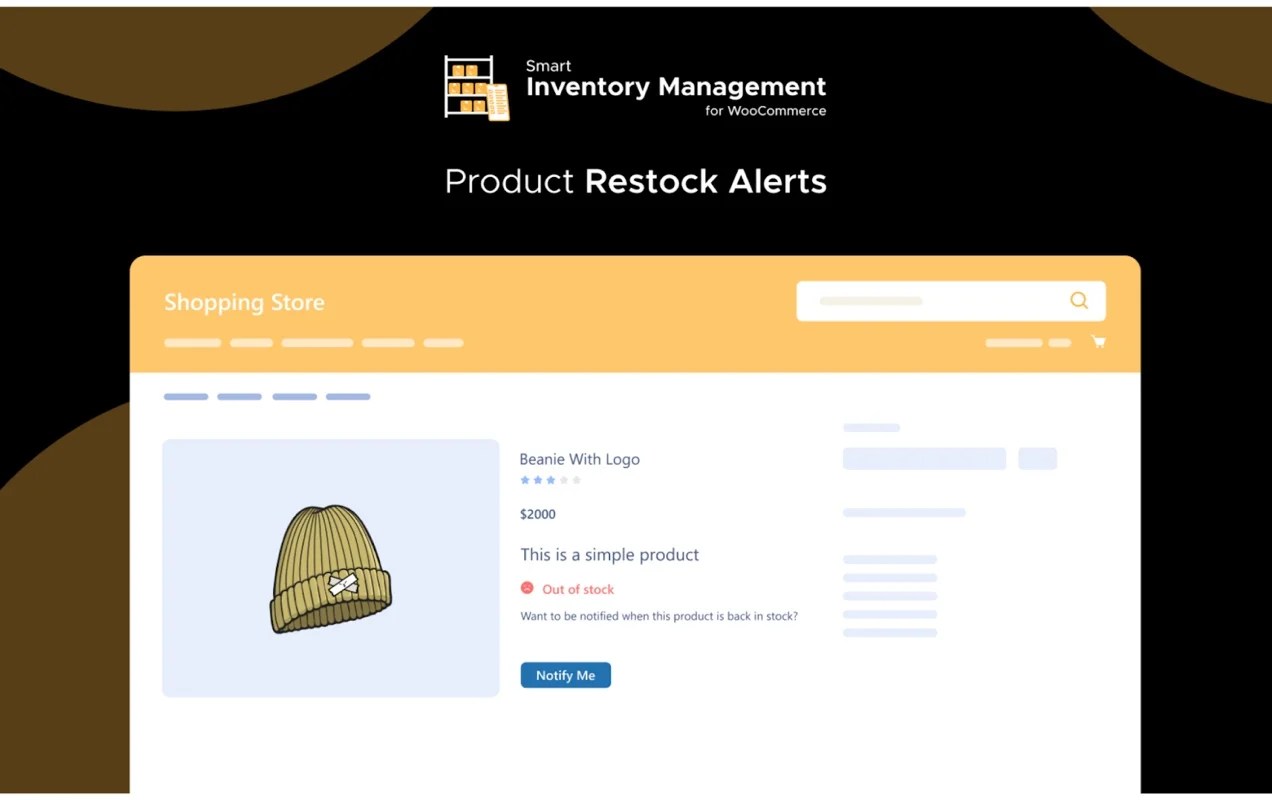
Smart Inventory Management for WooCommerce and Multi-Location Inventory are extensions that allow you to centrally manage your inventory across multiple locations directly within the WordPress dashboard. But some companies may prefer to import orders, product data, and stock levels from WooCommerce into a third-party inventory management software like Katana, MRPeasy, or Zoho Inventory.
2. Employ a distributed fulfillment strategy
Adopting a distributed fulfillment strategy leverages retail locations as micro-fulfillment centers. Instead of shipping from a single warehouse, stores can fulfill orders closer to the customer, reducing transit times and shipping costs. For example, a customer order in Los Angeles can be shipped directly from a local store rather than a central warehouse in Atlanta.
3. Leverage advanced shipping software
Utilizing advanced shipping software solutions like ShipStation, Shippo, or Easyship can optimize the shipping process if you’re selling on multiple ecommerce channels and accepting delivery from retail locations as well.
These tools integrate seamlessly with WooCommerce and other popular platforms, centralizing order fulfillment management and offering automation features like real-time shipping rates, automated label printing, and intelligent carrier selection based on speed, cost, and reliability.
4. Add ship-to-store capabilities and in-store pickup
Implementing ship-to-store solutions with an extension like Local Pickup Plus for WooCommerce speeds up delivery times, optimizes inventory turnover, and reduces package theft. Stores may act as fulfillment hubs and safe delivery locations. Additionally, this approach helps ecommerce businesses meet rising consumer expectations for fast shipping and personalized delivery choices, competing effectively against giants like Amazon.
5. Returns management from multiple locations
Managing returns across multiple locations can be challenging, so aim to keep this process as straightforward as possible. Offering customers the flexibility to return items to the closest retail location simplifies the process and reduces return shipping costs.
Try to make in-store returns quick and easy for employees as well. Implementing a returns management system on-site or dedicated online portal will ensure consistency, speed, and efficiency.
For companies managing multiple retail locations, ecommerce shipping is more than just logistics — it’s a strategic opportunity. Adopting these practices helps multi-location retailers that sell online thrive in a competitive marketplace.
Implement an ecommerce shipping strategy
↑ Back to topOnce you’ve done your research, weighed your options, and made some decisions, put your strategy into action.
1. Back up your store
Start by taking a full backup. If any unanticipated issues arise, this ensures you don’t lose valuable data and order information. We recommend Jetpack VaultPress Backup for this, which includes real-time backups as part of an ongoing ecommerce security strategy.
After the backup is complete, update WordPress, WooCommerce, your theme, and all plugins to ensure full compatibility with any new shipping and fulfillment extensions.
2. Configure WooCommerce settings
If you offer free shipping, local pickup, or flat rate shipping, you don’t need any extra plugins or extensions — everything is already built into WooCommerce.
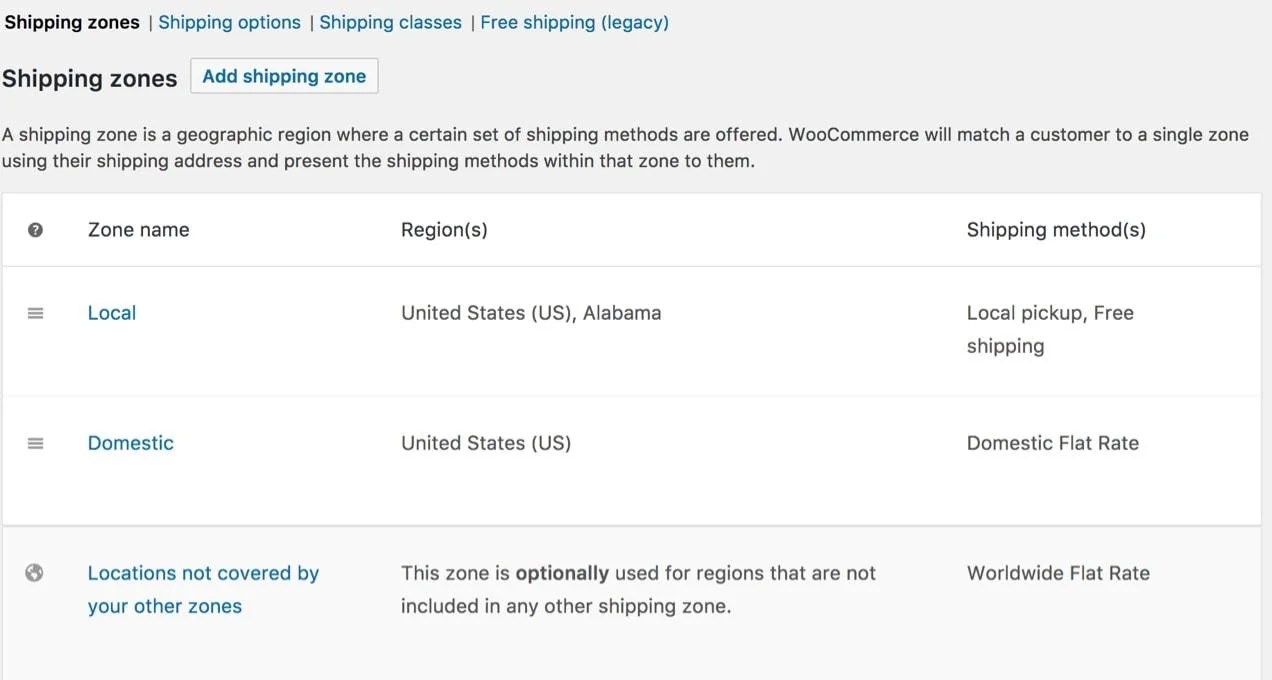
Navigate to WooCommerce → Settings → Shipping in your dashboard. There, create shipping zones to define rates based on customer locations, and shipping classes to define rates based on groups of similar products.
Let’s start by taking a look at shipping zones. By setting these up, you can define shipping rates based on specific areas. And you can either be pretty generic here (like defining rates by country) or hyper-specific (like defining rates by zip code). Don’t worry — no matter how complicated you get, each individual customer will only see the rates that apply to their shipping address.
Click on the Shipping zones tab and, if you haven’t set up a zone yet, you’ll see a prompt to do so.
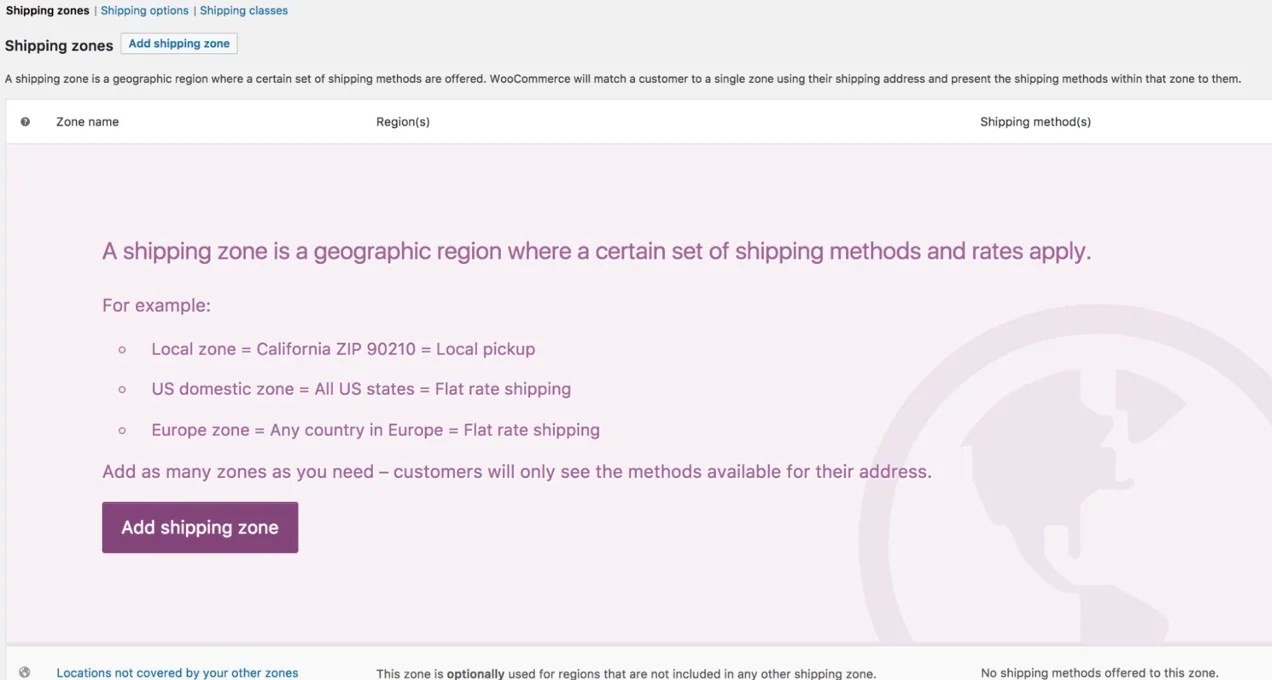
Click Add shipping zone.
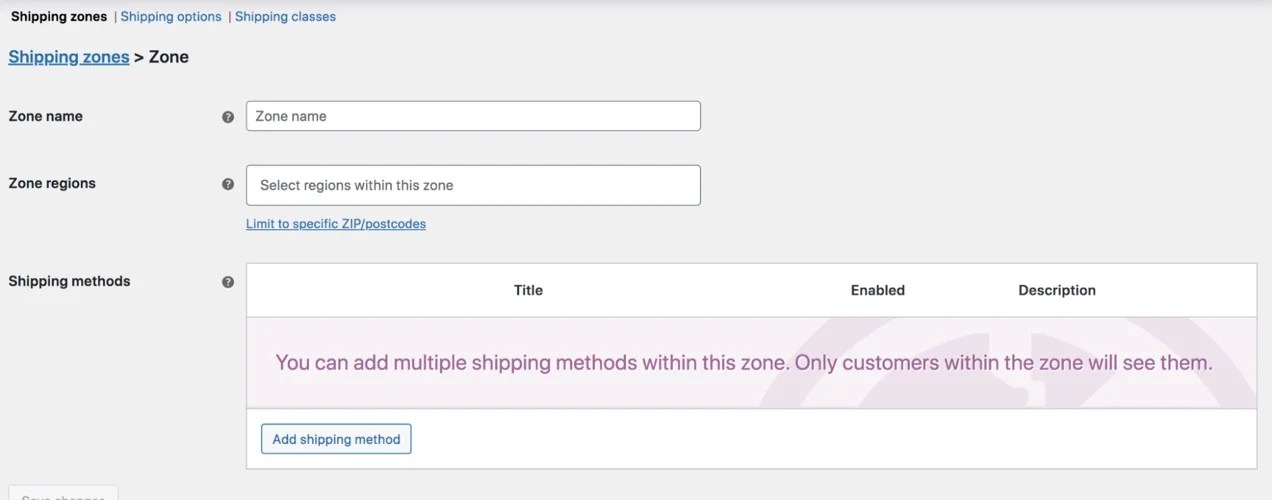
In the new window that opens, name the new zone. Then, select the shipping regions that will be included in this zone. There are a variety of ways to configure zones, so think through the best way to do so for your business.
For example, a retail store located in New York City might have zones for the East Coast, Midwest, and West Coast, with rates increasing in price based on distance from New York. Or a bakery might offer discounted rates just within their zip code, and higher rates to all other locations.
Select all the locations for this shipping zone. If you want to limit the zone based on zip code, click Limit to specific zip/postcodes. A new box will appear that allows you to enter a list of zip codes.
Next, define the shipping rates that are available for the new zone. Click the Add shipping rate button. By default, there are three options: flat rate, free shipping, and local pickup.
If you select Flat rate shipping, you’ll have the option to set a specific price for that zone (e.g. $9.99 flat rate shipping). You can also set this based on shipping class, which we’ll discuss in a moment.
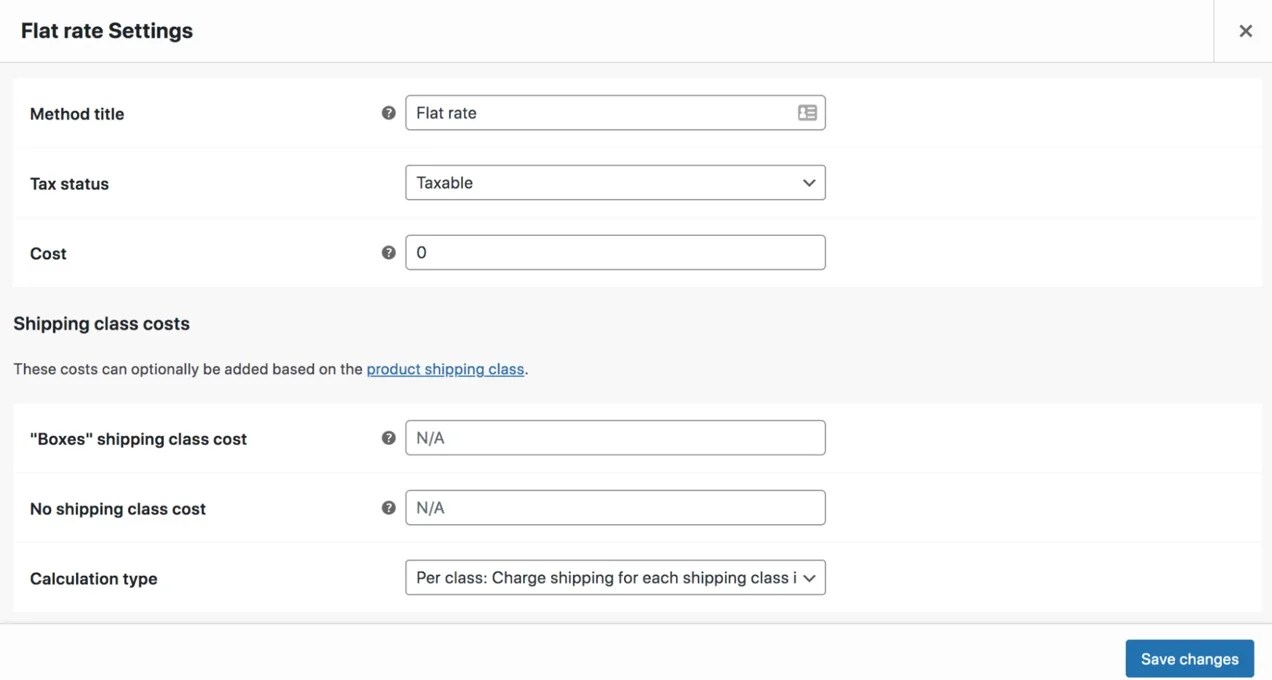
If you choose Free shipping, you can set a minimum order total required for free shipping, whether or not you want to associate free shipping with a coupon code, and more.

And if you go with Local pickup, customers who live inside of the set shipping zone will be able to pick up their order at your place of business.

Remember, you can add one or more of these items to each zone. So, for example, you could offer free shipping above a certain order total and flat rate for everything less than that total.
But what about shipping classes? While these aren’t required, they are an excellent way to set rates for different types of products. For example, you may sell unframed art prints, alongside framed ones. Not only will these cost different amounts to ship based on their weight, framed options will also require more packaging materials.
Let’s run with this example. In your dashboard, navigate to WooCommerce → Settings → Shipping, then click the Shipping Classes tab. There, click Add new shipping class in the bottom right corner of the page.
Then, add a class name, slug (URL), and description, and click Save shipping classes.

Now, assign products to each class. Go to Products → All Products and open the one you want to edit. Then, scroll down to the product data box and select the Shipping tab.
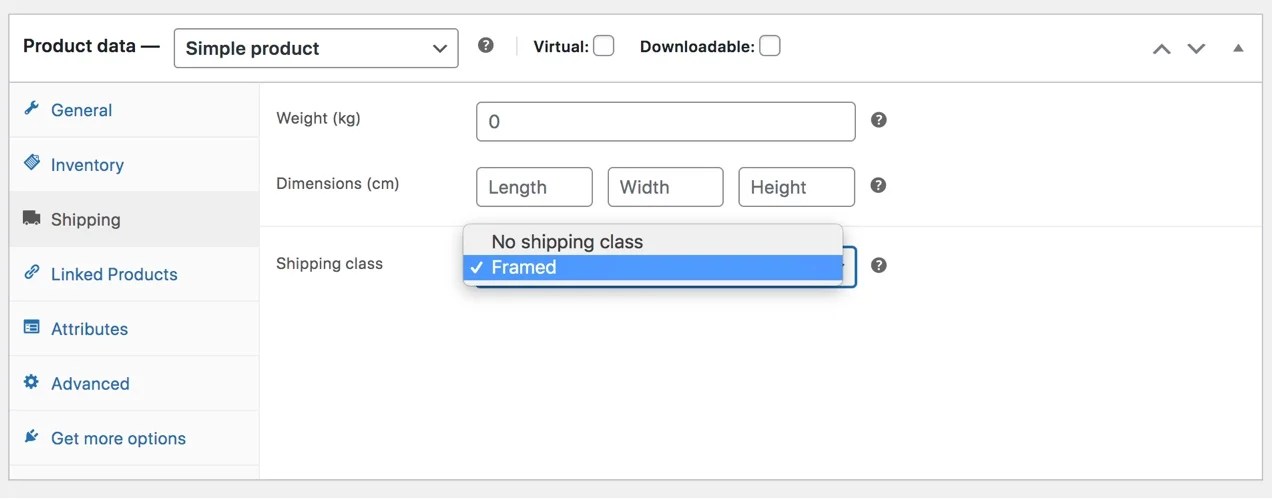
In the dropdown for Shipping class, select the class that best fits the product. Then, save your changes. Do this for each product in that class.
This allows you to get even more granular with shipping charges. So, for example, when you set up flat rate shipping, set a different price for framed vs. unframed prints. You’ll see in the screenshot below that there’s now a separate option just for the “framed” shipping class.
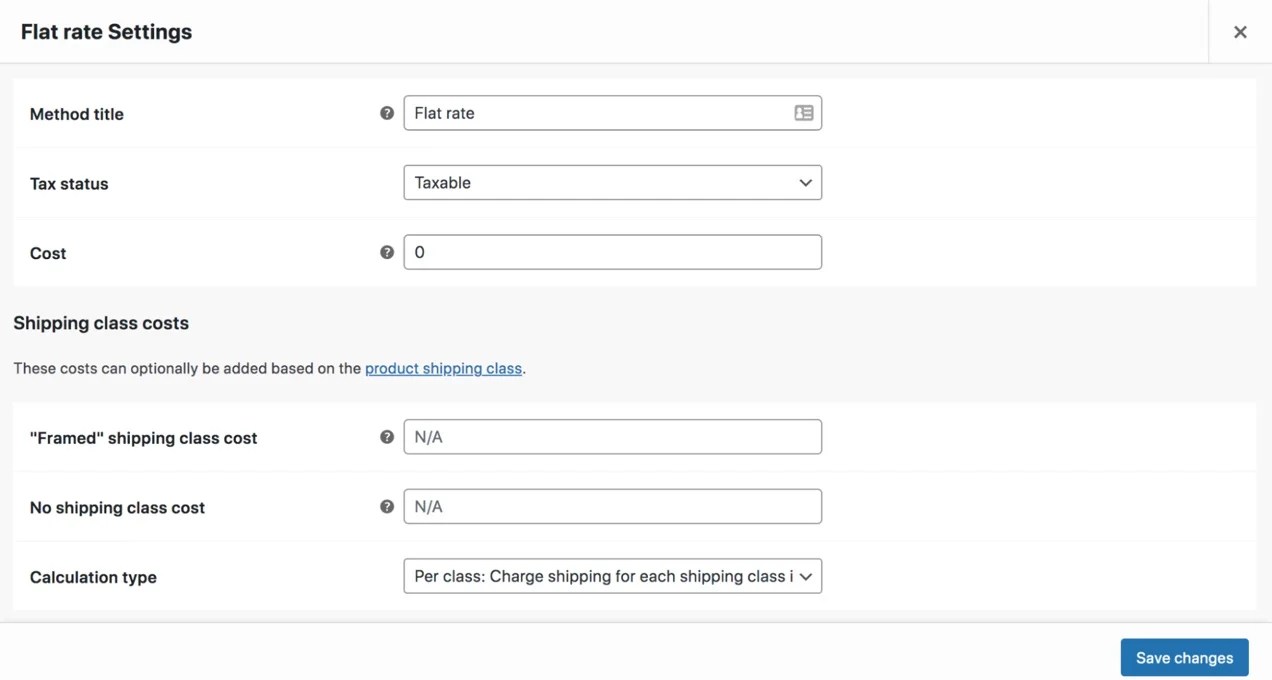
There’s a lot you can do with the default WooCommerce shipping settings. If you need to get into more advanced shipping configurations, move on to the next step — adding WooCommerce shipping extensions.
3. Install and activate shipping extensions
To implement table rates, live rates, or a combination, you’ll need an extension. You can also use WooCommerce extensions to print shipping labels, sync warehouse inventory, connect to third-party shipping software, and add a wide variety of other features.
Start by purchasing or downloading an extension from the WooCommerce Marketplace. Not sure which to use? Use our post about ecommerce shipping strategies to make the right decision for your store. Here are just a few great options:
- Table Rate Shipping: Set up very detailed rates based on factors like weight, number of items, location, price, and more.
- USPS Shipping Method: Define prices automatically based on live rates directly from USPS.
- Per Product Shipping: Set rates based on each individual product or even variation.
- WooCommerce Distance Rate Shipping: Offer different rates based on the customer’s distance from your location.
- WooCommerce Dropshipping: This streamlines the order fulfillment process with dropshipping providers by connecting and syncing order information.
If you’re looking for a way to power up and streamline your ecommerce shipping processes, consider using the WooCommerce Shipping extension. It enables you to print USPS and DHL labels directly from your WordPress dashboard and provides access to discounted rates. And it’s completely free!
Working with a 3PL service? They may have a WooCommerce extension available in the WooCommerce marketplace or directly from their website, or they may configure a custom integration.
4. Make it easy for customers to understand their order’s location
The ecommerce shipping process doesn’t stop once the package is with the carrier. In fact, some of the best opportunities for good customer service occur after the order is in the mail!
Customers should be able to quickly understand where their order is at all times, and know when they can expect it to arrive. This is especially important for items that are frequently purchased as gifts.
The Shipment Tracking extension is an excellent way to do just that. Not only will buyers receive an email with the tracking number for their order, they can also log into their account to check on its location. And it works seamlessly with USPS, UPS, FedEx, Canada Post, and more than a dozen other shipping carriers.
5. Consider return shipments
While no one likes to think about returns, they do happen. And if you accept exchanges or return shipments, it’s important to have a plan in place.
With the WooCommerce Shipping extension, you can create a new return shipping label for the order, use the customer’s address as the origin address, and update the package weight and size. Learn more about this in the WooCommerce Shipping documentation.
Also, clearly outline any and all expectations ahead of time. In your return policy, define exactly who is responsible for paying return shipping fees, and in what circumstances.
Put your shipping strategy to work with WooCommerce
↑ Back to topYou’re ready to start shipping! Remember to adapt your shipping strategy along the way and make changes as you learn about your customers. Over time, you’ll find options for fulfillment services, packaging materials, shipping carriers and methods, and shipping pricing structures that are good for customer relations and your bottom line.
Experiment with different ecommerce shipping solutions. Don’t be afraid to use a combination of fulfillment methods if it’s a good fit. For instance, you can use a 3PL for the majority of your goods, give customers the option of in-store pickup, and handle cargo yourself for wholesale orders.
Always look for ways to improve packaging effectiveness and brand impact while staying cost-conscious. Compare pricing from different suppliers, test new and interesting materials, and keep an eye on how competitors are handling packaging.
Monitor shipping carrier policy and rate changes and don’t be afraid to switch shipping services, add new shipping methods, or discontinue shipping to certain countries to balance customer experience, delivery costs, and legal compliance.
How you pass along shipping costs to customers is also a delicate area to navigate. You can charge customers a separate fee for shipping, or cover all or part of it yourself. If you do decide to charge for shipping, you can determine rates in almost unlimited ways — from flat rates to table rates and even live, real-time pricing fed from shipping carriers.
Finally, no matter how you choose to set up your ecommerce shipping strategy, WooCommerce has the tools to handle it all. Take advantage of extensions to ship products affordably, efficiently, and safely so happy customers stay happy and your store runs smoothly.
About



Need more informatio, thanks
Hi, Rana – thanks for commenting. Could you expand a little on the specific information you’re looking for? This will help us direct you to the correct place.
It’s worth mentionong that we have several other recent posts around shipping too:
Thanks!
Why does the price figure increase when I put two decimal places? This is something heavy. Thank you
Hi Hernan! Are you using default shipping functionality or an extension? Please feel free to reach out to customer support for more individualized help. https://woocommerce.com/my-account/contact-support/
Great breakdown! Having the right ecommerce shipping strategy really does make a difference. Whether you’re fulfilling in-house, dropshipping, or using a 3PL, it’s all about balancing cost, control, and customer experience. I also appreciate the reminder to factor in delivery zones and carrier options — especially when thinking about international expansion. Thanks for the helpful insights!
Thanks, Sam! Glad to hear it was helpful!
Tendances
A beginner’s guide to ecommerce SEO
By Kevin Bates •
How Landyachtz cut ecommerce costs by more than 75% and gained full control with WooCommerce
By Mahrie Boyle •
Prepare your business for 2026 EU tax changes
By Lynn J •
Never miss a beat — join our mailing list
Please enter a valid email.
View our privacy policy. You can unsubscribe anytime.
There was an error subscribing; please try again later.
Thanks for subscribing!
Emails will be sent to
You're already subscribed!
Emails are sent to